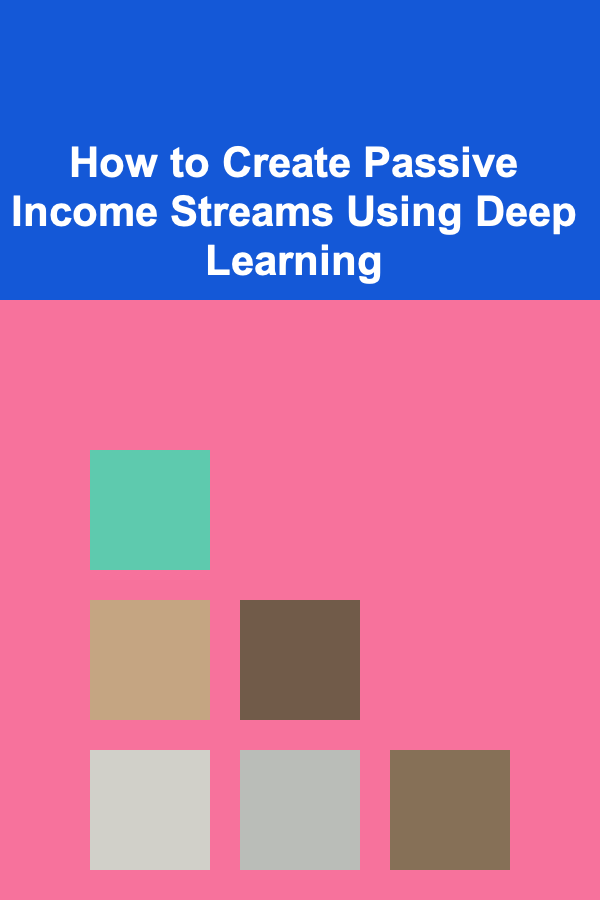
How to Create Passive Income Streams Using Deep Learning
ebook include PDF & Audio bundle (Micro Guide)
$12.99$8.99
Limited Time Offer! Order within the next:

In the fast-paced world of technology, deep learning has emerged as one of the most transformative forces, revolutionizing industries and empowering developers to build innovative solutions. As a deep learning practitioner, you possess a unique set of skills that can be leveraged to generate passive income streams. While working as a full-time developer is rewarding, there are ways to earn money without continuous active involvement, creating opportunities for financial independence, freedom, and the ability to focus on innovative projects.
In this article, we will explore various methods for deep learning developers to create passive income streams. These strategies will not only help you utilize your technical expertise but also enable you to contribute to a rapidly growing field. From developing AI models and educational content to monetizing software-as-a-service (SaaS) products, we'll dive into actionable steps you can take to start earning passive income from your deep learning skills.
Creating and Selling AI Models
Understanding the Demand for Pre-Trained Models
AI and machine learning models are in high demand across many industries. Businesses and organizations constantly seek pre-trained models that can help them solve specific challenges such as natural language processing (NLP), image recognition, fraud detection, and predictive analytics. The problem is, training these models from scratch is a costly and time-consuming process that requires substantial computational resources. Therefore, there's a growing demand for ready-made, pre-trained models that can be easily integrated into applications.
As a deep learning developer, you can tap into this demand by creating specialized models and selling them to businesses or developers who need them.
Steps to Create and Sell AI Models
-
Identify a Market Need: The first step is to understand where pre-trained models are most needed. Different industries have different requirements. For example:
- Healthcare: Image analysis models for early diagnosis (e.g., identifying signs of cancer in radiology images).
- Finance: Models for fraud detection, credit scoring, and algorithmic trading.
- Retail: Recommendation systems and demand forecasting models.
- Marketing: Customer segmentation models, sentiment analysis, and automated content generation.
-
Develop Specialized Models: Once you've identified a high-demand niche, create specialized models tailored to solve specific business problems. Use libraries like TensorFlow, Keras, or PyTorch to build and train your models. You can also make use of transfer learning to speed up the training process by leveraging pre-trained models and fine-tuning them for your use case.
-
Optimize Your Models: Ensure that your models are efficient and optimized for real-world deployment. Businesses are interested in models that can deliver results quickly and are resource-efficient. This means keeping an eye on the model's performance in terms of both accuracy and speed.
-
Monetize Your Models: Once your model is trained and optimized, you can list it for sale on popular AI marketplaces such as:
- Hugging Face Model Hub: This platform is great for sharing NLP models.
- TensorFlow Hub: Ideal for TensorFlow-based models across various domains.
- Modelplace.AI: A marketplace where you can sell pre-trained models for different applications.
By creating and selling AI models, you can generate a steady stream of passive income. Once uploaded to a marketplace, your models will continue to be available for purchase, and you can earn revenue without additional effort.
Building and Selling Online Courses
The Growing Demand for AI Education
With the rapid rise of artificial intelligence, there's a huge demand for education in deep learning. Many developers, data scientists, and engineers are eager to learn the intricacies of deep learning but may not know where to start. As an expert in the field, you can monetize your knowledge by creating and selling online courses.
Steps to Create and Sell Courses
-
Choose Your Niche: To stand out in the competitive online course market, focus on specific topics within deep learning that are in demand. Some popular topics include:
- Introduction to deep learning and neural networks
- Computer vision using deep learning
- Natural language processing (NLP) with deep learning
- Reinforcement learning and its applications
- Practical deep learning for production deployment
-
Create High-Quality Content: Plan your course structure carefully. Divide your content into digestible modules, and include practical, hands-on examples. Deep learning courses benefit from coding demonstrations, interactive exercises, and real-world case studies.
-
Choose a Platform to Host Your Course: There are several online platforms where you can host and sell your courses. Some popular options include:
- Udemy: One of the most popular course-selling platforms.
- Coursera: Ideal if you're looking to collaborate with universities or offer more structured courses.
- Teachable: This platform offers more control over branding and pricing.
-
Market Your Course: Once your course is live, marketing it becomes essential. Use social media platforms like Twitter, LinkedIn, and Reddit to share snippets of your content and engage with potential students. Additionally, create a blog or YouTube channel where you can share free tutorials to attract your audience.
-
Expand Your Offerings: As you grow your reputation as an educator, consider expanding your course offerings. Create advanced courses or specialized content that delves deeper into complex topics. You can also offer one-on-one mentorship or consulting services for a premium price.
Once your courses are published, they can continue generating income with little to no active involvement, allowing you to earn passive income while helping others learn deep learning.
Starting a Blog or YouTube Channel
Content Creation as a Passive Income Source
Building a blog or YouTube channel around deep learning can be a great way to establish yourself as a thought leader while creating an income stream. These platforms allow you to create valuable content, including tutorials, reviews, and educational videos, which can attract a large audience and open up various monetization opportunities.
Steps to Create a Blog or YouTube Channel
-
Choose Your Platform: Decide whether you want to create a blog or a YouTube channel. A blog is great for written tutorials, technical articles, and in-depth case studies, while YouTube is ideal for video tutorials, coding demonstrations, and interviews.
-
Create Valuable Content: Focus on producing high-quality, informative content that resonates with your target audience. Examples include:
- Step-by-step tutorials on building deep learning models.
- Case studies of how deep learning is applied in various industries.
- Reviews of deep learning tools and libraries.
-
Monetize Your Content:
- For Blogs: Once your blog generates significant traffic, you can start monetizing it using Google AdSense or other ad networks. You can also use affiliate marketing by promoting deep learning courses, books, or hardware related to AI. Additionally, sponsored content is an option as your blog grows.
- For YouTube: As your YouTube channel grows, you can apply for the YouTube Partner Program to enable ads on your videos. Another way to monetize is through affiliate marketing by promoting AI-related products or services. Sponsored content is another avenue that becomes available as your subscriber base expands.
-
Build a Community: Engage with your audience through comments, emails, and social media. Building a community of deep learning enthusiasts can help increase your reach and attract more sponsorship opportunities.
-
Scale Your Content: As you build your brand, consider expanding your content offerings. You could create a membership area on your blog, launch online workshops, or start selling your own digital products, such as eBooks or premium tutorials.
The beauty of blogging or YouTube is that once the content is created, it continues to generate revenue over time, often with little ongoing effort. This makes it an ideal strategy for generating passive income.
Developing and Monetizing SaaS Products
Software as a Service (SaaS) in AI
Another lucrative passive income stream is building and monetizing AI-powered Software as a Service (SaaS) products. These cloud-based solutions can help businesses automate tasks, optimize operations, and gain insights from data. By offering your deep learning expertise in the form of a SaaS product, you can create a recurring income stream.
Steps to Create and Monetize SaaS Products
-
Identify a Market Need: Find an area where deep learning can offer a unique solution. Potential ideas include:
- An image recognition SaaS tool for e-commerce platforms to automatically tag and categorize products.
- A predictive analytics tool for businesses in finance or healthcare.
- A natural language processing tool for automating customer support or chatbots.
-
Build the SaaS Platform: Develop the platform using frameworks like Flask or Django for the backend, and React or Vue.js for the front end. Make sure your product is easy to use, scalable, and can handle real-world data.
-
Offer Subscription Plans: Charge customers on a recurring basis by offering monthly or yearly subscription plans. You can offer different tiers of pricing, based on the number of users, features, or usage limits.
-
Automate Marketing and Customer Support: Use automated email campaigns, social media, and SEO to attract new customers. Additionally, implement automated customer support through chatbots or FAQ sections to reduce manual efforts.
A successful SaaS product can generate consistent passive income as customers continue to use and pay for the service, allowing you to scale the business while minimizing active involvement.
Participating in AI Competitions and Crowdsourcing Projects
Monetizing Skills Through Competitions
AI competitions are another way to earn passive income through deep learning. Platforms like Kaggle and DrivenData host competitions where developers can solve complex problems and earn prizes. While participating in these competitions isn't entirely passive, the knowledge gained can be applied to future projects that generate passive income.
Steps to Participate in Competitions
- Join Platforms like Kaggle: Kaggle hosts numerous competitions related to AI and machine learning. By participating, you can hone your skills and earn prizes for top-performing models.
- Collaborate with Teams: Many competitions allow team entries. Collaborating with other developers can increase your chances of winning and help you build a network of like-minded professionals.
- Monetize Your Success: If you perform well in competitions, you can use your achievements to attract consulting opportunities, create educational content, or build a reputation that drives traffic to your products or services.
Conclusion
Deep learning developers have numerous opportunities to generate passive income through the skills and knowledge they've acquired. Whether you choose to create and sell AI models, build and monetize educational content, start a blog or YouTube channel, develop SaaS products, or participate in competitions, there are multiple ways to leverage your expertise and create long-term income streams. The key is to choose a strategy that aligns with your strengths and interests, build high-quality content or products, and implement systems that allow you to earn income with minimal ongoing effort. By diversifying your passive income streams, you can secure your financial future and focus on the projects that truly excite you.
Reading More From Our Other Websites
- [Gardening 101] How to Choose the Perfect Garden Book for Your Gardening Style
- [Organization Tip 101] How to Create a Family Command Center for Schedules
- [Organization Tip 101] How to Organize Fine China and Crystal Stemware
- [Personal Care Tips 101] How to Add Moisture to Your Skin with Body Wash
- [Personal Care Tips 101] How to Incorporate Face Masks into Your Daily Skincare Routine
- [Personal Care Tips 101] How to Switch to an Eco-Friendly Toothbrush for a Greener Smile
- [Hiking with Kids Tip 101] Best Trail Games and Scavenger Hunts That Teach Kids About Ecosystem Diversity
- [Organization Tip 101] How to Create a Personal Library at Home
- [Biking 101] Top 5 Bike Pumps Every Cyclist Should Have in Their Gear
- [Organization Tip 101] How to Set Up a Jewelry Repair Station at Home

How to Declutter Your Digital Devices for Better Focus
Read More
How to Prepare for Virtual Presentations Effectively
Read More
How to Install a Security Camera System: A Comprehensive Guide
Read More
How to Build Healthy Habits for Mental Well-being
Read More
How to Build a Remote Controlled Robot Car with Arduino
Read More
How to Pray Using Bible Verses: 5 Effective Methods
Read MoreOther Products

How to Declutter Your Digital Devices for Better Focus
Read More
How to Prepare for Virtual Presentations Effectively
Read More
How to Install a Security Camera System: A Comprehensive Guide
Read More
How to Build Healthy Habits for Mental Well-being
Read More
How to Build a Remote Controlled Robot Car with Arduino
Read More